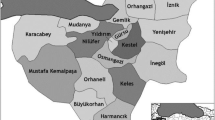Abstract
Ammonia emissions were estimated at five microclimatic locations in a free stall dairy building using four different methods. Measurements were performed simultaneously with the different methods to enable comparison. In the first method, the rate of ammonia emission from manure was theoretically modeled utilizing Fick’s law and boundary layer theory. In the second method, recirculation flux-chamber technique was used to model ammonia emission from manure. In the third and fourth methods, respectively, carbon dioxide and methane balances were employed to calculate ammonia emission. The mean ammonia emissions measured from the five locations using the different methods ranged from 0.10 to 0.15 g m−2 h−1. The percentage of variation of ammonia emission from the different location ranged between 8 and 52% for the different methods. Recorded ammonia emission rates in the dairy building were from 0.04 to 0.25 g m−2 h−1. The percentage of variation in ammonia, carbon dioxide, methane, and manure properties in the building was 50%. Two-way statistical analysis of variance showed that there were no significant differences (p > 0.63) between the four different methods or between the measurements obtained at the five locations (p > 0.90).











Similar content being viewed by others
References
Anderson N, Strader R, Davidson C (2003) Airborne reduced nitrogen: ammonia emissions from agriculture and other sources. Environ Int 29:277–286
Berckmans D (2004) Automatic on-line monitoring of animals by precision livestock farming. In: Animal production in Europe - The way forward in a changing world, International Society for Animal Hygiene (ISAH) congress, Saint-Malo, France
Blanes-Vidal V, Topper AP, Wheeler FE (2007) Validation of ammonia emissions from dairy cow manure estimated with a non-steady-state, recirculation flux chamber with whole-building emissions. Trans ASABE 50:633–640
CIGR (1999) Animal Production & Aquacultural Engineering, CIGR Handbook of Agricultural Engineering, Volume II, American Society of Agricultural Engineers, St. Joseph, Michigan
De Belie N, Richardson M, Braam CR, Svennerstedt JJ, Sonck B (2000) Durability of building matrials and components in the agricultural environment: Part I, The agricultural environment and timber structures. J Agric Eng Res 75:225–241
Erisman JW, Grennfelt P, Sutton M (2003) The European perspective on nitrogen emission and deposition. Environ Int 29:311–325
Flesch TK, Wilson JD, Harper LA, Crenna BP (2005) Estimating gas emissions from a farm with an inverse-dispersion technique. Atmos Environ 39:4863–4874
Groot Koerkamp PWG, Metz JHM, Uenk GH, Phillips VR, Holden MR, Sneath RW, Short JL, White RPP, Hartung J, Seedorf J, Schröder M, Linkert KH, Pedersen S, Takai H, Johnsen JO, Wathes CM (1998) Concentrations and emissions of ammonia in livestock buildings in northern europe. J Agric Eng Res 70:79–95
Incropera FP, DeWitt DP (1990) Fundamentals of heat and mass transfer. Wiley, New York, pp 344–369
Jacobson LD, Bicudo JR, Schmidt DR, Wood-Gay S, Gates RS, Hoff SJ (2003) Air emissions from animal production buildings. In: Proceedings of the XI International Congress ISAH 2003, Mexico City, Mexico
Johnson KA, Johnson DE (1995) Methane emissions from cattle. J Anim Sci 73:2483–2492
Jungbluth T, Hartung E, Brose G (2001) Greenhouse gas emissions from animal houses and manure stores. Nutr Cycl Agroecosyst 60:133–145
Kinsman R, Sauer FD, Jackson HA, Wolynetz MS (1995) Methane and carbon dioxide emissions from dairy cows in full lactation monitored over a six-month period. J Dairy Sci 78:2760–2766
Lefcourt AM (2002) Some potential problems for measuring ammonia emissions from farm structures. Trans ASAE 45:1585–1591
Monteny GJ, Smits MC, van Duinkerken G, Mollenhorst H, de Boer IJ (2002) Prediction of ammonia emission from dairy barns using feed characteristics part II: relation between urinary urea concentration and ammonia emission. J Dairy Sci 85:3389–3394
Ni JQ, Heber AJ (2001) Sampling and measurement of ammonia concentration at animal facilities–A review. American Society of Agricultural Engineers Annual International Meeting. Technical Paper Number 01–4090, St. Joseph, Michigan
Phillips VR, Lee DS, Scholtens R, Garland JA, Sneath RW (2001) A review of methods for measuring emission rates of ammonia from livestock buildings and slurry or manure stores, Part 2: monitoring flux rates, concentrations and airflow rates. J Agric Eng Res 78:1–14
Pinder RW, Pekney NJ, Davidson CI, Adams PJ (2004) A process-based model of ammonia emissions from dairy cows: improved temporal and spatial resolution. Atmos Environ 38:1357–1365
Pyle DL, Niranjan K, Varley J (1997) Mass transfer in food and bioprocesses. In: Fryer PJ, Pyle DL, Reilly CD (eds) Chemical engineering for the food industry fryer, 1st edn. Blackie, London, pp 181–183
Radon K, Danuser B, Iversen M, Monso E, Weber C, Hartung J (2002) Air contaminants in different European farming environments. Ann Agric Environ Med 9:41–48
SAS (2008) SAS/STAT 9.2. User’s guide. SAS Institute, Cary, NC
Sommer SG, Zhang GQ, Bannink A, Chadwick D, Misselbrook T, Harrison R, Hutchings NJ, Menzi H, Monteny GJ, Ni JQ, Oenema O, Webb J (2006) Algorithms determining ammonia emission from buildings housing cattle and pigs and from manure stores. Adv Agron 89:261–335
Teye KF, Hautala M (2007) Measuring ventilation rates in dairy buildings. Int J Vent 6:247–256
Teye FK, Hautala M (2008) Adaptation of an ammonia volatilization model for a naturally ventilated dairy building. Atmos Environ 42:4345–4354
Zhao B, Chen S (2003) Ammonia volatilization from dairy manure under anaerobic and aerated conditions at different temperatures. American Society of Agricultural Engineers Annual International Meeting, Technical Paper Number 034148, St. Joseph, Michigan
Author information
Authors and Affiliations
Corresponding author
Rights and permissions
About this article
Cite this article
Teye, F.K., Hautala, M. A comparative assessment of four methods for estimating ammonia emissions at microclimatic locations in a dairy building. Int J Biometeorol 54, 63–74 (2010). https://doi.org/10.1007/s00484-009-0255-y
Received:
Revised:
Accepted:
Published:
Issue Date:
DOI: https://doi.org/10.1007/s00484-009-0255-y




